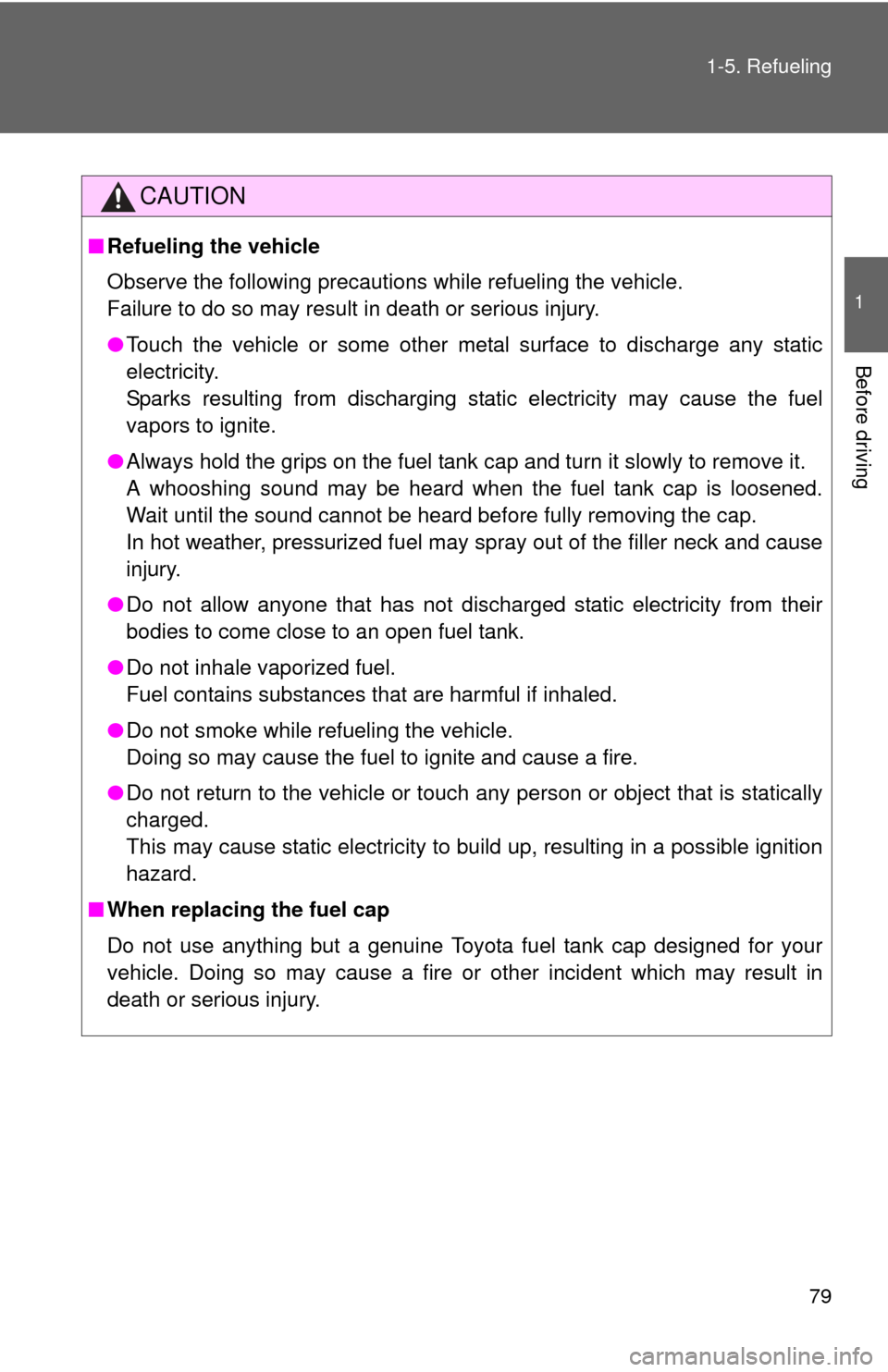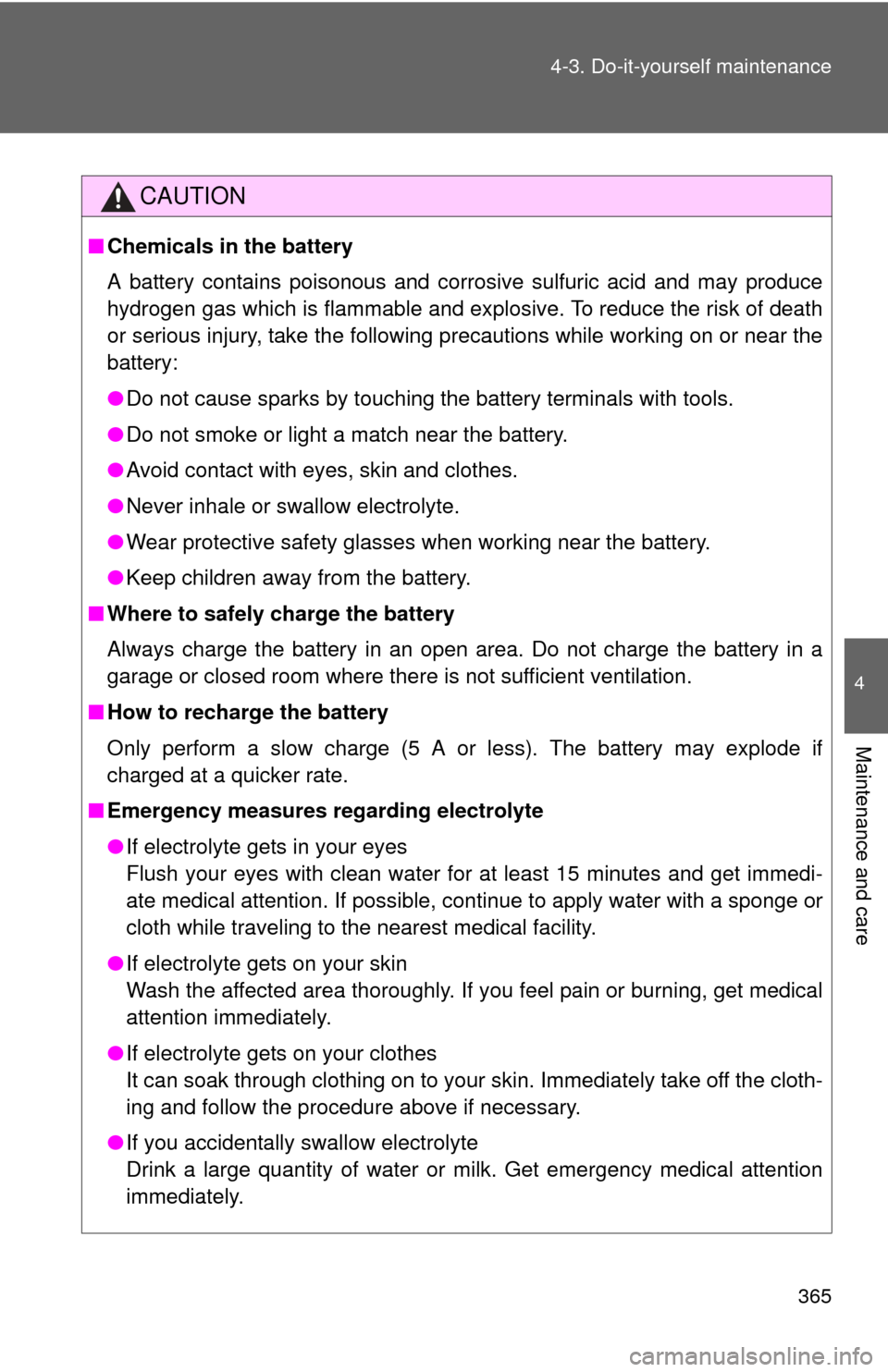2012 TOYOTA COROLLA Spark
[x] Cancel search: SparkPage 79 of 529

79
1-5. Refueling
1
Before driving
CAUTION
■
Refueling the vehicle
Observe the following precautions while refueling the vehicle.
Failure to do so may result in death or serious injury.
●Touch the vehicle or some other metal surface to discharge any static
electricity.
Sparks resulting from discharging static electricity may cause the fuel
vapors to ignite.
● Always hold the grips on the fuel tank cap and turn it slowly to remove it.
A whooshing sound may be heard when the fuel tank cap is loosened.
Wait until the sound cannot be heard before fully removing the cap.
In hot weather, pressurized fuel may spray out of the filler neck and cause
injury.
● Do not allow anyone that has not discharged static electricity from their
bodies to come close to an open fuel tank.
● Do not inhale vaporized fuel.
Fuel contains substances that are harmful if inhaled.
● Do not smoke while refueling the vehicle.
Doing so may cause the fuel to ignite and cause a fire.
● Do not return to the vehicle or touch any person or object that is statically
charged.
This may cause static electricity to build up, resulting in a possible ignition
hazard.
■ When replacing the fuel cap
Do not use anything but a genuine Toyota fuel tank cap designed for your
vehicle. Doing so may cause a fire or other incident which may result in
death or serious injury.
Page 347 of 529

347
4-3. Do-it-yourself maintenance
4
Maintenance and care
CAUTION
The engine compartment contains many mechanisms and fluids that may
move suddenly, become hot, or become electrically energized. To avoid death
or serious injury observe the following precautions.
■
When working on the engine compartment
●Keep hands, clothing, and tools away from the moving fan and engine
drive belt.
● Be careful not to touch the engine, radiator, exhaust manifold, etc. right
after driving as they may be hot. Oil and other fluids may also be hot.
● Do not leave anything that may burn easily, such as paper or rags, in the
engine compartment.
● Do not smoke, cause sparks or expose an open flame to fuel or the bat-
tery. Fuel and battery fumes are flammable.
● Be extremely cautious when working on the battery. It contains poisonous
and corrosive sulfuric acid.
● Take care because brake fluid can harm your hands or eyes and damage
painted surfaces.
If fluid gets on your hands or in your eyes, flush the affected area with
clean water immediately.
If you still experience discomfort, see a doctor.
■ When working near the electric c ooling fans or radiator grille
Vehicles with smart key system: Be sure the “ENGINE START STOP” switch
is OFF. With the “ENGINE START STOP” switch in IGNITION ON mode, the
electric cooling fans may automatically start to run if the air conditioning is on
and/or the coolant temperature is high. ( P. 361)
Vehicles without smart key system: Be sure the engine switch is OFF. With
the engine switch in the “ON” position, the electric cooling fans may auto-
matically start to run if the air conditioning is on and/or the coolant tempera-
ture is high. ( P. 361)
■ Safety glasses
Wear safety glasses to prevent flying or falling material, fluid spray, etc. from
getting in the eyes.
Page 365 of 529

365
4-3. Do-it-yourself maintenance
4
Maintenance and care
CAUTION
■
Chemicals in the battery
A battery contains poisonous and corrosive sulfuric acid and may produce
hydrogen gas which is flammable and explosive. To reduce the risk of death
or serious injury, take the following precautions while working on or near the
battery:
●Do not cause sparks by touching the battery terminals with tools.
● Do not smoke or light a match near the battery.
● Avoid contact with eyes, skin and clothes.
● Never inhale or swallow electrolyte.
● Wear protective safety glasses when working near the battery.
● Keep children away from the battery.
■ Where to safely charge the battery
Always charge the battery in an open area. Do not charge the battery in a
garage or closed room where there is not sufficient ventilation.
■ How to recharge the battery
Only perform a slow charge (5 A or less). The battery may explode if
charged at a quicker rate.
■ Emergency measures regarding electrolyte
●If electrolyte gets in your eyes
Flush your eyes with clean water for at least 15 minutes and get immedi-
ate medical attention. If possible, continue to apply water with a sponge or
cloth while traveling to the nearest medical facility.
● If electrolyte gets on your skin
Wash the affected area thoroughly. If you feel pain or burning, get medical
attention immediately.
● If electrolyte gets on your clothes
It can soak through clothing on to your skin. Immediately take off the cloth-
ing and follow the procedure above if necessary.
● If you accidentally swallow electrolyte
Drink a large quantity of water or milk. Get emergency medical attention
immediately.
Page 471 of 529

471
6-1. Specifications
6
Vehicle specifications
Cooling system
Ignition system
Capacity
(Reference)
1.8 L 4-cylinder (2ZR-FE) engine
5.8 qt. (5.5 L, 4.8 Imp. qt.) 2.4 L 4-cylinder (2AZ-FE) engine
6.0 qt. (5.7 L, 5.0 Imp. qt.)
Coolant type Use either of the following.
• “Toyota Super Long Life Coolant”
• Similar high-quality ethylene glycol-based non-silicate, non-amine, non-nitrite, and non-borate coolant with
long-life hybrid organic acid technology
Do not use plain water alone.
Spark plug
Make
Gap 1.8 L 4-cylinder (2ZR-FE) engine
DENSO SC20HR11 2.4 L 4-cylinder (2AZ-FE) engine
DENSO SK20R11
NGK IFR6A11
0.043 in. (1.1 mm)
NOTICE
■ Iridium-tipped spark plugs
Use only iridium-tipped spark plugs. Do not adjust spark plug gap.
Page 521 of 529

521
Alphabetical index
Seat belts
Adjusting the seat belt ............ 58
Automatic Locking
Retractor .............................. 61
Child restraint system
installation .......................... 107
Cleaning and maintaining the seat belts...................... 337
Emergency Locking Retractor .............................. 61
How to wear your seat belt ..... 58
How your child should wear
the seat belt ......................... 62
Pregnant women, proper seat
belt use ................................ 61
Reminder light ...................... 422
Seat belt extenders ................ 62
Seat belt pretensioners .......... 60
Seat heaters ............................. 326
Seating capacity ...................... 180
Seats Adjustment ............................. 51
Adjustment precautions .......... 53
Child seats/child restraint system installation.............. 107
Cleaning ............................... 336
Head restraint ......................... 56
Properly sitting in the seat ...... 84
Rear seat folding down........... 54
Seat heaters ......................... 326
Service reminder indicators .............................. 152 Shift lever
Automatic transmission .........139
If the shift lever cannot
be shifted from P................. 446
Manual transmission .............145
Shift lock system .....................446
Side airbags................................86
Side marker lights Replacing light bulbs .............399
Switch....................................160
Wattage .................................475
Side mirror Adjusting and folding ...............69
Smart key system
Entry function ..........................25
Starting the engine ................131
Spare tire
Inflation pressure...................376
Storage location ....................432
Spark plug ................................471
Specifications...........................464
Speedometer ............................149
Steering
Column lock release......133, 137
Steering wheel Adjustment ..............................66
Audio switches ......................275
Stop lights Replacing light bulbs .............399
Wattage .................................475
Storage feature.........................311S